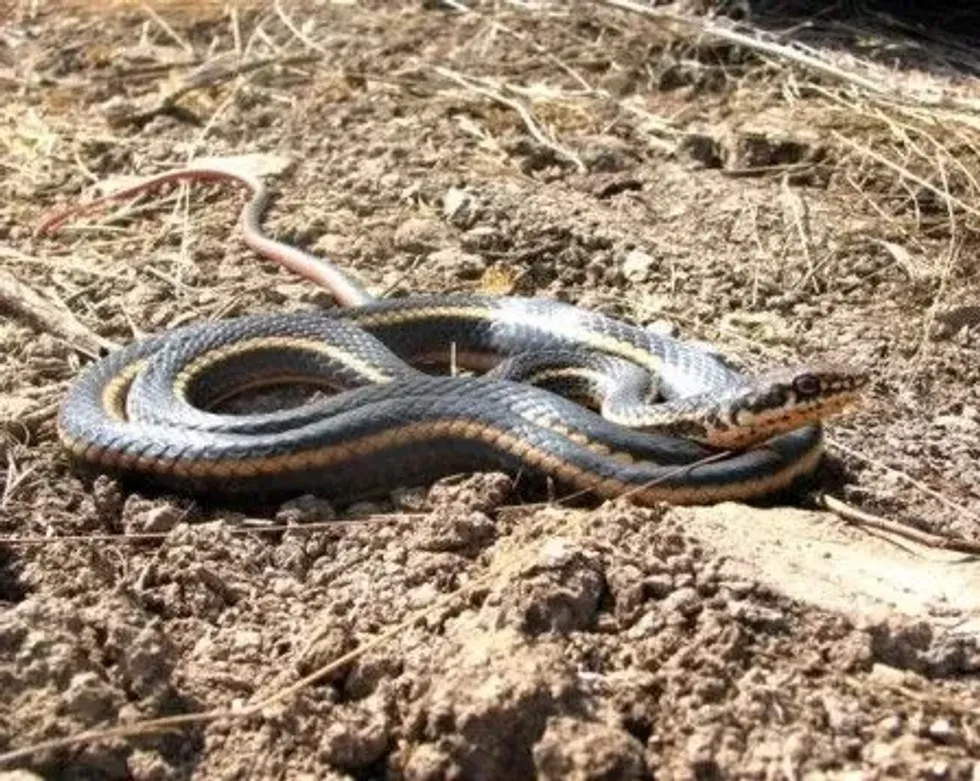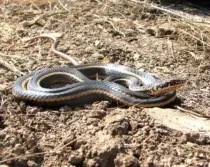Interested in racer snakes? Then you may be curious about the striped racer.
Living in parts of California, Mexico, and San Francisco, the species of California whipsnake, also known as the striped racer and the subspecies Alameda whipsnake is an abundantly found non-venomous snake. However, their existence is endemic to these parts, mostly for the Alameda whipsnake, which can only be found in very limited places in San Francisco.
While the California whipsnake prefers chaparral foothills, shrublands, and rocky canyons, Alameda whipsnakes are more inclined to coastal sage scrub and rock crevices.
Apart from a little color difference, their physical appearance is almost the same. They have long, slender bodies, along with a wide head and stripes running along their body on both sides. Whether the species is adorable or not can be a debatable matter, but they indeed are interesting.
These snakes are extremely fast and they are also great climbers. Although non-venomous, they are vicious and tend to strike and bite if they feel threatened or are trying to be handled.
To learn more interesting facts about this species, keep on reading.
Do you like to read about interesting species of amphibians and reptiles from all across the world? Then don't forget to read about the monitor lizard and lava lizard too!
Striped Racer Interesting Facts
What type of animal is a striped racer?
The California striped racer (Masticophis lateralis), also known as the California whipsnake, is a long, slender-bodied snake living in parts of California and Mexico. Although often confused with the Alameda striped racer (Coluber lateralis euryxanthus), both are different subspecies.
What class of animal does a striped racer belong to?
Both the California striped racer and Alameda striped racers belong to the Reptilia class of the animal kingdom. Although these reptiles are not venomous, they tend to strike if someone tries to capture them.
How many striped racers are there in the world?
The exact number of striped racer snakes in the world is unknown. It can be said that they are found in abundance in their natural habitat, however, their geographic range is very limited.
Where does a striped racer live?
The geographic range of the Calfornia striped racer is very limited. They can be found in parts of Mexico, and of course, California.
On the other hand, Alameda striped racers (Coluber lateralis euryxanthus) are endemic to California. They are found in Alameda County, which in fact gives them their name, and in San Francisco Bay (more precisely, on the east side of San Francisco Bay).
What is a striped racer's habitat?
The California whipsnake's (Masticophis lateralis) natural habitat consists of chaparral foothills, shrublands, rocky canyons, watercourses, oases, mixed deciduous forests, pine woodlands, and semidesert regions. Whereas, the Alameda whipsnake (Coluber lateralis euryxanthus) prefers coastal sage scrub, rock crevices, rock outcrops, and mammal burrows. These whipsnakes are incredible climbers.
Who do striped racers live with?
Similar to many other species of snakes, the California whipsnake (Masticophis lateralis) and the Alameda whipsnake (Coluber lateralis euryxanthus) prefer to live alone.
How long does a striped racer live?
The average life expectancy of these whipsnakes is unknown, however, the lifespan of the Colubridae family is approximately around eight years.
How do they reproduce?
According to the Houghton Mifflin company published book, 'A Field Guide To Western Reptiles And Amphibians', females lay eggs during late spring through early summer. It takes two to three months for the eggs to hatch, and the young whipsnakes to be born.
The breeding season occurs during late March and goes on until mid-June. While males wander around in search of a partner, females prefer to stay near the hibernation sites. Eventually, males find their partner, mating occurs and the females lay between six and 11 eggs.
What is their conservation status?
According to the International Union for Conservation of Nature (IUCN) Red List, California whipsnakes (Masticophis lateralis) are a Least Concern species. However, the conservation status of the Alameda whipsnakes (Coluber lateralis euryxanthus) is Not Evaluated.
Striped Racer Fun Facts
What do striped racers look like?
According to the Houghton Mifflin company published book, 'A Field Guide To Western Reptiles And Amphibians', both the California whipsnake (Masticophis lateralis) and the Alameda whipsnake (Coluber lateralis euryxanthus) are quite long and have a slender body. They also have long, slender tails.
Another very distinguished feature of these whipsnakes is the patterns on their body. The patterns can range in color from dark brown to black, with yellow or orange-colored stripes on each side. Their head is significantly broader as compared to their body.
* Please note that this is an image of a Sonoran whipsnake, not a striped racer snake. If you have an image of a striped racer, please let us know at hello@kidadl.com.

How cute are they?
Calling snakes cute can be a debatable matter. However, both the California whipsnake (Masticophis lateralis) and the Alameda whipsnake (Coluber lateralis euryxanthus) have really interesting looks. Both the subspecies have beautiful patterns, which give them a unique look. However, don't forget that whipsnakes, although non-venomous, are fast-moving and tend to strike aggressively.
How do they communicate?
Although the exact communication process of the whipsnake is not known, it will be safe to assume that this species of whipsnake uses similar methods to communicate as other snake species. They use their tongue to collect chemicals and analyze their environment.
They use the vomeronasal system that is used by most amphibians and reptiles to gather information about their prey and their predators. Snakes also use this system to communicate with other snakes.
How big is a striped racer?
Both the California whipsnake (Masticophis lateralis) species and the Alameda whipsnake (Coluber lateralis euryxanthus) species are quite long species of snakes. While the California whipsnake's length can range between 30-48 in (76-122 cm), the Alameda whipsnake's length range is between 35-48 in (91-122 cm).
The California whipsnake can grow as long as 60 in (152 cm).
These snakes can grow almost 15.7 in (40 cm) longer than the most venomous snake in California: the rattlesnake. When compared to the eastern diamondback rattlesnake, they are slightly shorter as the diamondback rattlesnake measures 48-96 in (122-244 cm).
How fast can a striped racer move?
They are a fast-moving species of snakes, which is also evident by their name. Although the exact speed of this whipsnake is not known, a subspecies named the southern black racer is the third-fastest snake in the world. These snakes can move at speed of 10 mph (16 kph).
How much does a striped racer weigh?
Though the exact weight of these snakes is not known we can make an assumption based on their family Colubridae, where the average weight range is 3.3-31.7 oz (94-900 g).
What are their male and female names of the species?
Male and female snakes of the species do not have any specific names. Thus, both are known as a striped racer or whipsnake.
What would you call a baby striped racer?
Baby striped racers are called snakelets.
What do they eat?
Similar to any other species of snake, striped racers are also carnivores. Striped racer snakes eat lizards, frogs, birds, salamanders, rodents, large insects, and even other snakes.
Are they poisonous?
Both subspecies are non-venomous, thus they do not possess any threat in this manner to human beings. However, these speedy snakes living in the chaparral foothills of California and San Francisco Bay tend to strike if someone tries to catch them.
Would they make a good pet?
Although non-venomous, don't forget that both subspecies are comfortable living in the wild, which is their natural habitat. With their tendency to strike and a tendency to avoid human contact, these snakes can be a handful to be kept as pets at home.
Did you know...
Both subspecies of whipsnakes have acute vision. In their natural habitat, these snakes can often be found foraging on the ground, holding their head and forward part of their body up from the ground, in search of food.
Do striped racers bite?
Striped racers are pretty vicious and would definitely bite, not once but several times, if they feel threatened.
Striped racer vs garter snake
The striped racer and garter snake can be often confusing, given their similarity in looks. Both have long, slender bodies with stripes running along their body on both sides. However, what sets these two apart is that the striped racer has two stripes, while the garter snake has three.
Here at Kidadl, we have carefully created lots of interesting family-friendly animal facts for everyone to discover! Learn more about some other reptiles from our black mamba facts and king cobra facts pages.
You can even occupy yourself at home by coloring in one of our free printable Striped racer coloring pages.










